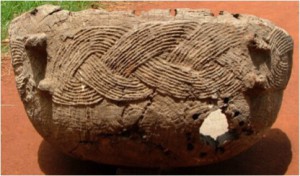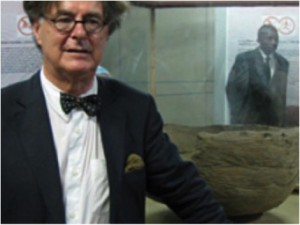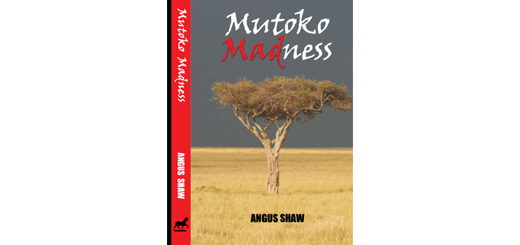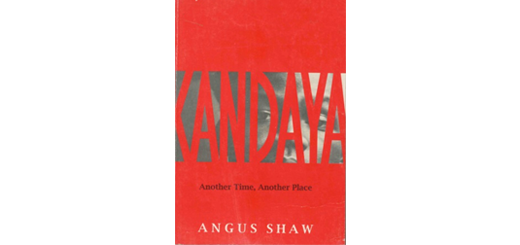The legend of the Ark of the Covenant and the disputed Zimbabwe connection
The legend of the Ark of the Covenant and the disputed Zimbabwe connection
By ANGUS SHAW
According to legend, white lions of God and a two-headed snake guarded the “drum that thunders” in a cave in southwestern Zimbabwe’s sacred Dumbwe mountains.
But, after an Indiana Jones-like tale of intrigue and adventure, the 700-year-old relic some believe is a holy replica of the Ark of the Covenant in which the Israelites carried the 10 Commandments as they traveled to the Promised Land from Egypt, has provoked bitter debate.

The bowl-shaped relic, according to British Professor Tudor Parfitt who unearthed it in a Zimbabwe museum storeroom in 2007, could have come from the Middle East with descendants of Aaron, the brother of Moses who crafted the original Ark of the Covenant for the tablets of God’s commandments he brought down from Mount Sinai.
But skeptics argue it is purely African, a vessel symbolizing immense tribal powers, hence the fierce mythical guardians in the cave. It is about 45 inches by 24 inches wide and 27 inches deep with a pattern of shallow engraving on the outside that could have held gold or tin threads. Scorch marks on the base inside were possibly left by primitive gun powder.
Parfitt, a professor of Modern Jewish Studies at the University of London’s School of Oriental and African Studies, first heard of the vessel during his research into the lost Jewish tribes of Africa over two decades beginning in the 1980s.
Various biblical and historical accounts say the original Ark of the Covenant was used to part the waters of the River Jordan for the Israelites to escape from Egypt. But it may have been destroyed in the Temple of King Solomon and stripped of its gold decorations when the Babylonians invaded Jerusalem in 586 B.C. It is likely several copies were made and one was taken to Ethiopia by the son of King Solomon and the Queen of Sheba, Prince Menelik. Another could have found its way to ancient Zimbabwe.
Ethiopian legend has it that the Queen of Sheba herself ventured south to “black Africa” and places the treasures of King Solomon’s mines in the gold reefs of Mount Fura, now known as Mount Darwin in northeastern Zimbabwe.
Zimbabwean historian Rob Burrett disputes Parfitt’s theories on the origins of the “drum that thunders,” or “Ngoma Lungundu” in the Shona language, also known as “the voice of God” by the waLemba tribe that claims it.
“He is on the wrong track. Wooden drums _ ceremonial drums and war drums with great powers similar to those attributed to the Ark _ are an integral part of ancient African culture,” he said.
The British professor’s research said genetic tests showed 52 percent of waLemba, also known as the Remba people, carried a Y chromosome known as the Cohen Modal Haplotype (CMH) _ unique to ancient Jewish communities. Other groups in Zimbabwe had no CMH.
Genetics also showed black Jewish communities in southern African could be the descendants of Aaron, brother of Moses.
“That doesn’t prove anything,” said Burrett.
Legend and accounts by early explorers such as David Livingstone spoke of the caravans and columns of pack animals of Swahili traders venturing deep inland from the east African coast where there was a strong Arabic and ancient Jewish presence.
“These people were certainly not celibate and would have created mixed blood communities along the way,” Burrett said, creating the genetic findings Parfitt speaks of.
The waLemba tribe shared similar religious practices and beliefs to those of Judaism _ observing a weekly holy day of Sabbath, unlike neighboring tribes they practiced circumcision, they didn’t eat pork and they observed practices of slaughtering animals similar to Jewish tradition.
One thing is certain though: a splinter from the top of the artifact has been carbon dated to circa 1300, making it probably the oldest surviving wooden object in southern Africa.
Parfitt said according to oral tradition, the waLemba could have been among peoples who left Judea in ancient Palestine 2,500 years ago and migrated through Yemen to east Africa, Ethiopia and beyond, bringing the ark with them.
African traditionalists, however, insist the Ngoma is purely African, a royal, tribal drum so powerful that it imploded and was rebuilt on the original wooden base 700 years ago.
Only carbon dating of the entire object, including its scorched base, would resolve the debate once and for all, but Zimbabwe authorities are reluctant to let that happen. In a nation striving to eradicate tribalism, a result favoring Parfitt’s claims might imply the waLemba were not truly African and stir tribal passions.
The Ngoma had been found by Swedish German missionary Harald von Sicard in the 1940s and wound up in the museum in the second city of Bulawayo.
He, said Burrett, was an “”old fashioned, Old Testament” missionary with fiercely conservative views bordering on racism who believed the Ngoma was not crafted by Africans, much as right wing colonial era theorists insisted Africans could not have built Great Zimbabwe, the houses of stone in the Shona language, the massively symbolic ruins of a stone city in the south of the country from which the country takes its name.
Archeologists subsequently established it was built by the ancient and advanced Shona civilization ruled by the Monomatapa tribal dynasty in the 14th Century.
Parfitt’s search for the legendary lost ark, guided by Arabic writings and oral African legends, took him through the Middle East to South Africa _ where his car was shot up by gunmen _ and on to the Bulawayo museum.

But the relic had gone missing, Parfitt said. He spent weeks living in a waLemba community south of Bulawayo looking for clues.
He learned “it was far too sacred to be kept in a museum and it was taken back and hidden again in a most secret place.” But no one knew where.
“There comes a time when you run out of elders and old people to ask,” Parfitt said. He was about to give up and go home when he met a retired train driver in a Bulawayo bar. The railway veteran said he recalled hauling a goods train of artifacts to Harare for safekeeping at the height of the guerrilla war that ended white rule in the former British colony of Rhodesia, as Zimbabwe was known before independence in 1980.
Parfitt admits he is an obsessive man. He searched the Harare museum in 2007 _ and there it was, in a dusty storeroom peppered with mouse droppings. After he published his findings a year later, the controversy began. Some people thought it was all a sinister plot and I was interfering. There was open hostility,” he said.
Tempers flared at a history seminar at the University of Zimbabwe and traditionalists stormed out in protest at Parfitt’s theory and denounced the presence of the British scholar.
Ken Mufuka, a professor of history from Zimbabwe who teaches at Lander University in South Carolina, called Parfitt a “publicity monger” and “a charlatan” in a weekly newsletter published in Harare.
The Briton acknowledge theories counter to his are “wholly plausible.”
Rob Burrett, also an associate researcher at the Bulawayo museum, said the Ngoma furor was rooted in the nation’s more recent political history dominated by President Robert Mugabe and loyalists _ including academics serving as ministers in education and social and cultural fields in the government since independence in 1980.
“There was a fear of undermining the post-independence myth that we are one people not divided by tribe or origin. It’s as though we are in denial of having a multicultural society,” he said.


